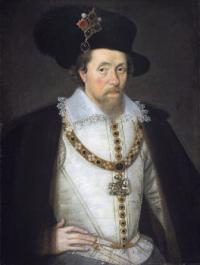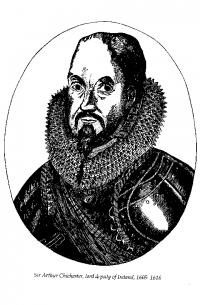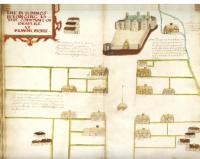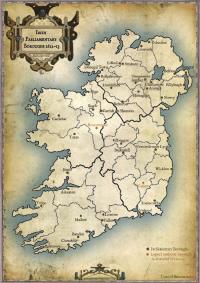The greatest gerrymander in Irish history? James I’s 40 boroughs of 1612–13
Published in Early Modern History (1500–1700), Features, General, Issue 2 (March/April 2013), Volume 21
James I—his accession in 1603 set the scene for a major reorganisation of Ireland’s urban network. (Scottish Portrait Gallery)
In 1603 two events—the establishment of a united Ireland under English rule for the first time, and the accession of James I—set the scene for a major reorganisation of Ireland’s urban network. The new monarch pursued a two-pronged urban policy in his Irish kingdom: first, the autonomy of the existing urban network was greatly reduced; second, urbanisation was promoted through the revival and expansion of existing towns and the foundation of new ones, particularly in Ulster, previously the least urbanised province. Existing Irish borough lost their city-state status and were transformed into ordinary municipal towns on the English model: debarred from pursuing an independent trade or foreign policy; obliged to conform to some degree to the established church; and compelled to remit their revenue from tolls and customs to the Crown, thus ending their financial autonomy. Medieval towns such as Tralee, Sligo and Cavan, and ancient episcopal sees like Armagh, Clogher and Tuam, were rejuvenated and their economic role promoted.
James and his ministers also pressed ahead vigorously with the policy of plantation, particularly in Ulster and Munster, which in turn resulted in the establishment of new towns. Thus it was envisaged that 25 new corporate towns would be established as part of the Ulster Plantation, while in Munster the mega-planter Richard Boyle established Bandon and Clonakilty, and the smaller Leitrim Plantation resulted in the founding of Carrick-on-Shannon and Jamestown. Outside the formal plantations, towns such as Boyle, Roscommon and Castlebar were also established. Such urban development also included incorporation, which was regarded as an integral part of the process, with the aim of attracting settlers, generating economic growth and providing more Protestant MPs to the Irish parliament.

The lord lieutenant, Sir Arthur Chichester—the king delegated the task of determining the composition of parliament to him.
Packing the parliament of 1613
Although the Irish parliament had originated in the late thirteenth century, it only met irregularly until the 1690s and for most of its existence was more of an event than an institution. Like its English counterpart, it consisted of a House of Lords and a House of Commons. Long controlled by the Catholic Old English, it was regarded as their bulwark against anti-Catholic measures and the encroachments of the Protestant New English. Each county and municipal town returned two MPs to the Commons, but until the reign of James I large parts of the country were unrepresented. The number of counties that received writs to attend Elizabeth’s parliaments increased from twenty in 1560 to 27 by 1585, while the respective numbers for the boroughs increased from 29 to 36. In total, 37 municipal towns received writs of election in the reign of Elizabeth, all in Munster and Leinster, except for two each in Connacht (Galway and Athenry) and Ulster (Carrickfergus and Downpatrick).The extension of English rule to all of Ireland resulted in the creation of new counties, while the plantations necessitated the establishment of new borough corporations. After 1603 the number of functioning counties increased to 33 and four new boroughs were created: Derry (1604), Athlone and Dingle (1607) and Cavan (1611). As T.W. Moody wrote in 1940, ‘it was reasonable enough to increase the number of corporate boroughs, especially in Connacht and Ulster, which were now within the normal operation of the central government’.In 1610 it was decided to hold the first Irish parliament for a quarter of a century—the first genuine all-Ireland parliament, with representatives from previously unconquered Gaelic Irish parts of the country. As its main business, however, was to be the tightening up of anti-Catholic legislation and the confirmation of the Ulster Plantation, considerable thought was given to its composition, as measures would have to be included to cope with an expected Catholic majority in the Commons (in 1585 the Irish House of Commons had 126 members and a Catholic majority). Having decided against the exclusion of Catholics through imposing the Oath of Supremacy, and realising that the exercise of influence would not on its own produce a Protestant majority in the Commons, the government turned to other expedients.
In 1611 Sir George Carew (1555–1629), the former president of Munster, was sent to Ireland to investigate the main problems facing the government there. Carew’s solution was simple but effective: new boroughs under firm Protestant control should be created to manufacture a Protestant majority—eight in Munster, four in Leinster, four in Connacht and 22 in Ulster. The king delegated the task of determining the composition of parliament to his lord lieutenant, Sir Arthur Chichester (1563–1625), who in the same year drew up a list of 35 new boroughs plus the University of Dublin, from which, he wrote with disarming candour, ‘they may expect Protestant burgesses’. Of these, twenty were to be in Ulster, eight in Munster, four in Connacht and three in Leinster. In the same document, Chichester calculated that without these new creations Catholics would outnumber Protestants by 85 to 61 in the Commons overall, and by 52 to 28 for the boroughs. On the other hand, the new creations would result in Protestants outnumbering Catholics by 123 to 95.
‘The more the merrier’
All of this activity alarmed the Catholic Old English, and in November 1611 six of them—Lords Gormanstown, Slane, Killeen, Trimblestown, Dungan and Louth—sent an angry letter of protest to the king, deploring ‘the project of erecting so many corporations in places that can scantly pass the rank of the poorest villages in the poorest country in Christendom’, and urging him ‘not to erect towns and corporations places consisting of some few poor and beggarly cottages’. The government pressed ahead and the king dismissed their complaints in jocular fashion—‘What is it to you whether I make many or few boroughs? . . . what if I had made 400 borough . . . The more the merrier’. He was as good as his word and 40 boroughs were created between November 1612 and May 1613 (including Carlow and Roscommon, both re-foundations from the Middle Ages). In the same year, Trinity College was erected into a parliamentary constituency. Clogher, which had a charter of unknown vintage, was also included, and with the addition of the four boroughs already created by James since his accession the total number of Irish boroughs was increased from 37 to 83. Consequently, the 1613 House of Commons had a Protestant majority of 232 to 100. The 40 new boroughs all returned Protestants, as did Derry, Athlone and Cavan, while the 37 old ones returned 57 Protestants and 17 Catholics. King James, Carew and Chichester had planned well. In 1614 Sir John Davies, speaker of the Irish Commons and attorney-general of Ireland, wrote to the earl of Somerset that ‘the newly erected boroughs . . . will be perpetual seminaries of Protestant burgesses, since it is provided in the charters that the provost and twelve chief burgesses, who are to elect all the rest, must always be such as will take the Oath of Supremacy’. The Old English lost control of the Irish parliament for the first time, and the status of the existing parliamentary boroughs was diluted and reduced as a result of the establishment of so many new ones.

Thomas Raven’s ‘The buildings belonging to the Company of Drapers at Monnemore’ (1622)—like the Spaniards in America, the English government had long promoted urbanisation as a means of broadening and deepening its control in Ireland. (Drapers’ Hall)
Urbanisation as a means of control
Nevertheless, the desire to pack the Irish parliament was not the sole or perhaps even the principal reason for the creation of the 40 boroughs. Concerning Ulster, R.J. Hunter wrote in 1971 that ‘urban planning in the plantation merged with the more politically inspired spate of borough-making throughout the island, which was a tactic of parliamentary management’. It should not be forgotten that parliament was only an occasional feature of the Irish administration, and its composition while important, was not paramount in the government’s strategic approach. On the other hand, the development of the urban network was a continuous process. Like the Spaniards in America, the English government had long promoted urbanisation as a means of broadening and deepening its control in Ireland. As Brid McGrath has pointed out, ‘the length of time since the previous parliament, and the government’s long established policy of encouraging the growth of towns as an instrument of extending “civility” over the country . . . also meant that many new towns, frequently based on old settlements, had been formed in the previous three decades, and it was natural that some of these be incorporated’. Other ‘legitimate candidates for incorporation’ included medieval towns such as Newry, Carlow, Sligo and Ennis, and ancient episcopal sees like Armagh and Tuam. In addition, the government did not want to alienate the Old English élite more than was necessary, owing to their status as an important part of the Irish élite and in order not to disturb a kingdom that had only just been pacified.
Constitutional arrangements
The boroughs created after 1603 received charters that differed considerably from those issued heretofore. Each of the new charters placed the government of the borough in the hands of a council (usually with a total membership of twelve or thirteen) consisting of a chief officer, known as a sovereign, portreeve, provost or warden, and a number of councillors or free burgesses. In each case the charter nominated the first chief officer and burgesses and stipulated that all had to conform to the established church by taking the Oath of Supremacy, thus guaranteeing a built-in Protestant monopoly. The role of the freemen was severely curtailed in four major areas: first, the chief officer and senior officials were all elected by the council; second, vacancies to the council were filled by co-option; third, MPs were also elected by the council, thus creating tiny twelve- or thirteen-man electorates; and last, admissions to the freemen were given exclusively to the council. In the older boroughs these functions had been exercised (however nominally) by the freemen, but many of the new boroughs came to have no freemen at all and in consequence became known as ‘closed’ corporations or ‘corporation boroughs’. Oligarchy had long been the norm in Irish urban government, but the novelty of the seventeenth-century charters lay both in their explicit provision for it and the extremely small ruling bodies that they established.
Another curb on the autonomy of the new Ulster boroughs was the policy of granting the lands of the new boroughs to a superintending landowner or patron rather than to the borough corporation as a body, with the proviso that the patron had responsibility for the development of the town. This had the dual effects of impoverishing the new boroughs and making them dependent on their respective patrons.
 Subsequent status
Subsequent status
It is instructive to trace the subsequent fate of the 40 boroughs by comparing them to the general body of Irish boroughs before the 1840s and by examining their current demographic status. There were 117 boroughs in Ireland from 1685 to 1800, all of which became extinct or were abolished between 1800 and 1841. Of these, 54% became municipal again under the reform legislation of 1828–54 and 46% did not. Of the 40 boroughs of 1613, 67% became municipal again and 33% did not. Similarly, eighteen (15%) of all 117 boroughs were described by the 1835 Report into Irish Boroughs that preceded municipal reform as having had no meaningful existence except as parliamentary constituencies. Of these, only five (12.5%) were 1613 creations.
Currently, 27 of the 40 boroughs are in the Republic and thirteen in Northern Ireland. Sixteen of those in the Republic are municipal while eleven are non-municipal. In Northern Ireland, six of them give their name to a district council while seven are non-municipal. According to the most recent census returns, 34 of the 40 towns have a population of over 1,000; 28 have more than 2,500; and seventeen have over 10,000. One, Belfast, has a population of over 100,000; one, Bangor, has 50,000–100,000; six have 20,000–30,000 (Carlow, Coleraine, Ennis, Newry, Newtownards and Tralee); ten have 10,000–20,000 (Armagh, Castlebar, Dungannon, Enniscorthy, Enniskillen, Limavady, Mallow, Sligo, Strabane and Wicklow); four have 5,000–10,000 (Bandon, Monaghan, Roscommon and Tuam); twelve have 1,000–5,000 (Askeaton, Ballyshannon, Belturbet, Boyle, Carrick-on-Shannon, Clonakilty, Donegal, Kilbeggan, Killyleagh, Lifford, Lismore and Newcastle-near Lyons); and six have under 1,000 (Augher, Ballinakill, Baltimore, Charlemont, Fethard and Tallow). This would suggest that while James I’s creation of the 40 boroughs was indeed one of the greatest gerrymanders in Irish history, it was also much more than this, as their subsequent development was very much in line with that of the generality of Irish towns, and in some respects was better. HI
Matthew Potter is Historian with the Mount St Lawrence Cemetery Joint Project, a collaboration between Limerick City Council and Mary Immaculate College.
Further reading
R.J. Hunter, ‘Towns in the Ulster Plantation’, Studia Hibernica 11 (1971), 40–79.
B. McGrath, ‘The membership of the Irish House of Commons 1613–15’ (unpublished MLitt. thesis, Trinity College Dublin, 1985).
T.W Moody, ‘The Irish parliament under Elizabeth and James I: a general survey’, Proceedings of the Royal Irish Academy 45C (1939–40), 41–81.
















